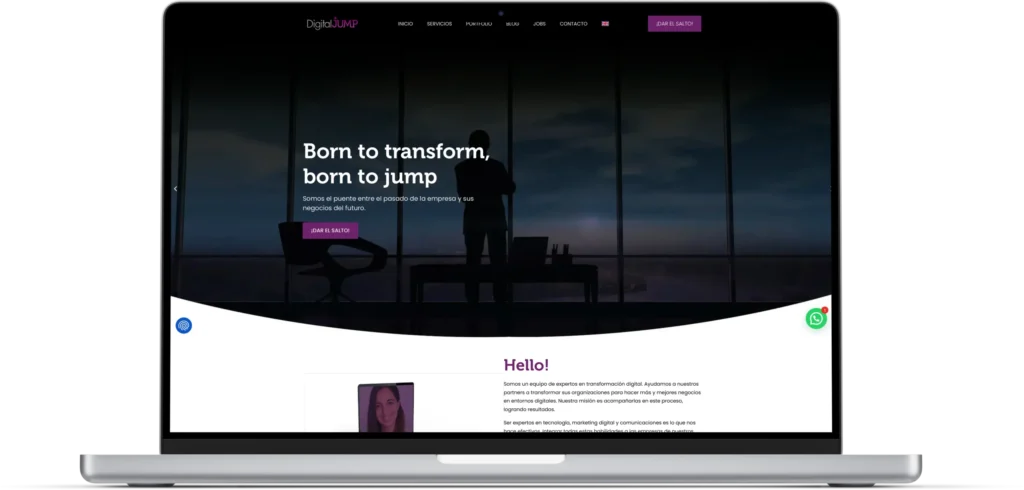In the development market there is a wide variety of websites that meet certain objectives. The following list defines the most common types.
The reason for labeling them as such is given, above all, by the objective they intend to fulfill: sales, capture of leads, information, etc. These categories are what we consider to be the most general, and within each of them, their by-products are broken down by the business model that the brand may pursue. We tell you some examples of them in this note so that you can understand where some of these by-products fit.

Landing page
It is also known as a “landing page” and is a web page designed specifically to convert visitors into leads or customers. It is a digital marketing tool that seeks to capture the attention of users and offer them something of value in exchange for their contact information or a specific action.
They differ from conventional web pages because they have a single and clear objective, and do not contain distracting elements that could distance the user from converting. For example, you may have a form, a buy button, an explainer video, or a downloadable file, but you won’t have a navigation menu, external links, advertising banners, or irrelevant information.
Landing pages are often used in online advertising campaigns, such as Google Ads, Facebook Ads or email marketing, to direct traffic to a specific offer and measure its effectiveness. Thus, you can optimize the return on investment (ROI) and increase sales or subscribers.
Most common types of landing pages
- Microsites: In simple terms, a landing page is a companion website that is developed to assist in online marketing campaigns. It usually has its own URL and is branded as such, as customers are attracted by paid online ads. Microsites are similar to landing pages, but are made for purely promotional purposes and extend the function of the main website.
- Lead capture: This type of page is developed to capture potential customers and is one of the most used within a marketing funnel. They allow you to collect and store relevant information about potential customers, allowing you to create more targeted messages with specific segmentation. They are often preferable for capturing leads who are in the middle stages of a funnel.
- Sales landing page: They are usually implemented in a deep stage of a sales funnel, that is, in a stage in which customers are already very loyal. It is one of the most difficult to design since they have the direct intention of selling. Its size can be short or long, depending on the product or service offered, and the amount of valuable information necessary to explain its benefits to the user.
Informational websites
Its main objective is to provide information on a specific topic, such as health, education, science, culture, etc. It usually has a clear and organized structure, with sections, categories, tags and links that make it easy to navigate and search for content. In addition, it usually has reliable and up-to-date sources that support the veracity and quality of the information offered.
An example is Wikipedia, the free online encyclopedia that contains millions of articles on various topics written and edited by volunteers from around the world. It is an informative website because it offers objective, neutral and evidence-based information, which can be consulted free of charge and without restrictions.
Most common types of informational websites
- News portals: Traditional press and magazines, in addition to their printed version, usually have a web version. Even today there are news sites that only have the web version.
- Blogs: These are sites that are developed so that articles on certain topics can be written and published. They are widely used by content creators, agencies or some companies to share notes related to the products or services they offer or to transmit information that may be of value to the target audience.
- Corporate or institutional: they are the official sites of companies or institutions, whose purpose is to offer general information about their activity and other important characteristics such as contact information, job opportunities, history, events, news and, of course, show their products and services ( Unlike e-commerce, these do not have payment gateways or shopping carts, but only information about them).
- Online catalogs: There is a dilemma in how to categorize this type of website, since it is an ecommerce but at the same time it is not. The big difference is that ecommerce enables the possibility of purchasing products, services or subscriptions. However, an online catalog, although it has practically the same complexity as an ecommerce in terms of structure and development, does not have a payment gateway, so it ends up being a merely informative site where products or services are listed and additionally, they have some call to action to consult for them.
Ecommerce:
They are websites that allow you to buy and sell products or services over the Internet. They are also known as “e-commerce websites” or “online stores.” They offer many advantages to both consumers and sellers, such as convenience, variety and speed in purchasing goods.
These are not only informative websites, but they have a persuasive nature on the target audience that encourages them to make purchases. In that sense, it is a category that also tends to be very dynamic in terms of the content it will display.
It is normal to find, for example, many who, in addition to having their own store section, also have a corporate section or a blog. Others will only have their products or services listed and with calls to action to make purchases. But ultimately, what makes them distinctive will always be their final action: the purchase.
Most common types of ecommerce
- Online product stores: These stores can sell everything from clothing and accessories to books and electronics, to food and entertainment.
- E-Learning: These are online learning course sites. They can have different themes, levels and durations, and are usually designed by experts in the field of study. They offer a series of advantages for students, such as flexible schedules, accessibility from anywhere, interactivity with other participants and possibility of self-assessment. Typically, these courses are sold individually on the website, but brands also offer annual or monthly subscription systems with access to all courses or some course categories.
- Digital product stores: These are online platforms that allow content creators or brands to sell their works in digital format, such as e-books, courses, podcasts, videos, music, etc. These stores offer advantages for both sellers and buyers, making it easier to access, distribute and pay for digital products. Like e-learning, they also usually sell resources individually or through subscriptions.
- Marketplaces: These are websites that allow sellers and buyers of products or services to connect, without the platform being the owner of them. It acts as an intermediary, facilitating the buying and selling process and charging a commission for each transaction. Some examples are Mercado Libre, Amazon, eBay, Airbnb or Uber.
Conclusion:
These are the most common websites on the market according to our vision. As we said at the beginning, not all projects necessarily fall into these categories that we defined. Many of them are to solve very particular problems of a brand and we cannot necessarily label it with any of these that we describe.
Despite everything, at Digital JUMP we evaluate and audit your needs and requirements to determine what may be the best solution for your business, whether you want to sell or promote your products or services or simply want to formalize the image of your company on the internet.
We focus on creating unique and personalized websites that achieve results using the power and flexibility of WordPress to develop them. This allows us to provide you with a final product that has excellent quality standards and that is also friendly to the needs of your business.
Anything, do not hesitate to contact us.


